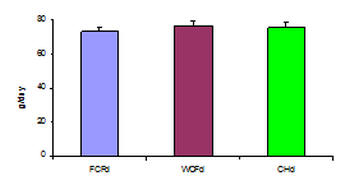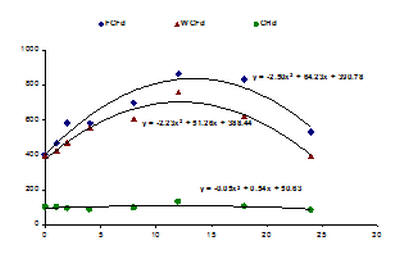 |
 |
| Figure 1: Growth rates of lambs supplemented with fresh, wilted or sun-dried cassava foliage | Figure 2. Regression of thiocyanate content in urine during 24 hours |
|
MEKARN Conference 2010 |
Weaned lambs of the Phan Rang breed with an initial weight of 15.0 kg and 3.5 months of age were used to study the effects of feeding fresh, wilted and sun-dried cassava foliage (Manihot esculenta Crantz) on feed intake, digestibility, growth performance, HCN consumed and thiocyanate concentration in urine during 24 hours. The treatments were three diets containing guinea grass (Panicum maximum) and cassava chips supplemented with fresh cassava foliage (FCFd), wilted cassava foliage (WCFd) or cassava hay (CHd). Six male lambs were used in a digestibility trial in a double 3*3 Latin square design and twenty-four lambs (6 males and 18 females) in a growth trial lasting 84 days. Dry matter intake ranged from 33 to 36 g/kg body weight. No significant difference between treatments was observed in live weight gain, which was 73.1, 76.7 and 75.6 g for FCFd, WCFd and CHd, respectively. The DM digestibility was significantly higher, 674 and 687 g/kg DM for FCFd and WCFd, compared to 600 g/kg DM for CHd. The nitrogen retained was 3.2, 3.8 and 3.5 g/day for FCFd, WCFd and CHd, respectively, and was not significantly different among treatments. Hydrogen cyanide content in fresh cassava foliage, wilted cassava foliage and cassava hay was 333, 217 and 60 mg/kg DM, and the amount consumed was significantly different among treatments, 114.6, 86.6 and 25.5 mg/day for FCFd, WCFd and CHd, respectively. The thiocyanate concentration in the urine of the lambs from diet CHd was significantly lower compared to diets FCFd and WCFd, where the thiocyanate level in urine increased from before feeding, reaching a peak at 12 h after feeding and then decreasing.
Key words: Manihot esculenta Crantz, lambs, growth, digestibility, HCN and thiocyanate
 |
 |
| Figure 1: Growth rates of lambs supplemented with fresh, wilted or sun-dried cassava foliage | Figure 2. Regression of thiocyanate content in urine during 24 hours |